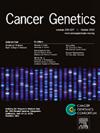Potential factors underlying the progression of RUNX1-mutated MDS to AML
IF 2.1
4区 医学
Q4 GENETICS & HEREDITY
引用次数: 0
Abstract
This study explores the molecular distinctions between myelodysplastic neoplasms (MDS) and acute myeloid leukemia (AML) with RUNX1 mutations (RUNX1mut), aiming to elucidate factors influencing the progression from MDS to AML. Analyzing 1520 patients (773 AML and 747 MDS cases), RUNX1mut were present in 10 % of MDS and 13 % of AML cases. Interestingly, RUNX1mut were associated with higher blast counts in MDS, suggesting a potential role in disease progression. Despite similar overall survival across subgroups, significant differences in variant allele frequency (VAF) were observed, correlating with blast count. Our study highlights a unique genetic signature in both RUNX1mut MDS and AML: Cytogenetic analysis showed a higher frequency of normal karyotypes in RUNX1mut-MDS compared to RUNX1mut-AML. While only trisomy 8 was found in MDS, trisomies 8, 11, and 13 were detected in RUNX1mut-AML. Notably, MECOM rearrangements, KMT2A-PTD, and FLT3-ITD alterations were exclusive to RUNX1mut-AML. RUNX1 mutations were strongly associated with spliceosome gene mutations, especially in RUNX1mut-MDS. Copy neutral loss of heterozygosity (CN-LOH) involving RUNX1 was detected in 22 % of RUNX1mut-AML cases but was absent in RUNX1mut-MDS. These findings highlight the distinct genetic landscape of RUNX1mut-MDS and AML. Understanding these molecular determinants may enhance monitoring and early intervention strategies for MDS patients at risk of progression to AML.
runx1突变MDS发展为AML的潜在因素
本研究探讨骨髓增生异常肿瘤(MDS)与RUNX1突变的急性髓系白血病(AML)的分子差异,旨在阐明MDS向AML发展的影响因素。分析1520例患者(773例AML和747例MDS), 10%的MDS和13%的AML患者存在RUNX1mut。有趣的是,RUNX1mut与MDS中较高的细胞计数相关,提示其在疾病进展中的潜在作用。尽管亚组之间的总生存率相似,但观察到变异等位基因频率(VAF)的显著差异,与blast计数相关。我们的研究强调了RUNX1mut MDS和AML中独特的遗传特征:细胞遗传学分析显示,与RUNX1mut-AML相比,RUNX1mut-MDS中正常核型的频率更高。虽然在MDS中只发现了8三体,但在RUNX1mut-AML中检测到了8、11和13三体。值得注意的是,MECOM重排、KMT2A-PTD和FLT3-ITD改变是RUNX1mut-AML所独有的。RUNX1突变与剪接体基因突变密切相关,尤其是在RUNX1mut-MDS中。涉及RUNX1的拷贝中性杂合性缺失(CN-LOH)在22%的RUNX1mut-AML病例中检测到,但在RUNX1mut-MDS中不存在。这些发现突出了RUNX1mut-MDS和AML的独特遗传格局。了解这些分子决定因素可以加强MDS患者进展为AML风险的监测和早期干预策略。
本文章由计算机程序翻译,如有差异,请以英文原文为准。
求助全文
约1分钟内获得全文
求助全文
来源期刊

Cancer Genetics
ONCOLOGY-GENETICS & HEREDITY
CiteScore
3.20
自引率
5.30%
发文量
167
审稿时长
27 days
期刊介绍:
The aim of Cancer Genetics is to publish high quality scientific papers on the cellular, genetic and molecular aspects of cancer, including cancer predisposition and clinical diagnostic applications. Specific areas of interest include descriptions of new chromosomal, molecular or epigenetic alterations in benign and malignant diseases; novel laboratory approaches for identification and characterization of chromosomal rearrangements or genomic alterations in cancer cells; correlation of genetic changes with pathology and clinical presentation; and the molecular genetics of cancer predisposition. To reach a basic science and clinical multidisciplinary audience, we welcome original full-length articles, reviews, meeting summaries, brief reports, and letters to the editor.
 求助内容:
求助内容: 应助结果提醒方式:
应助结果提醒方式:


